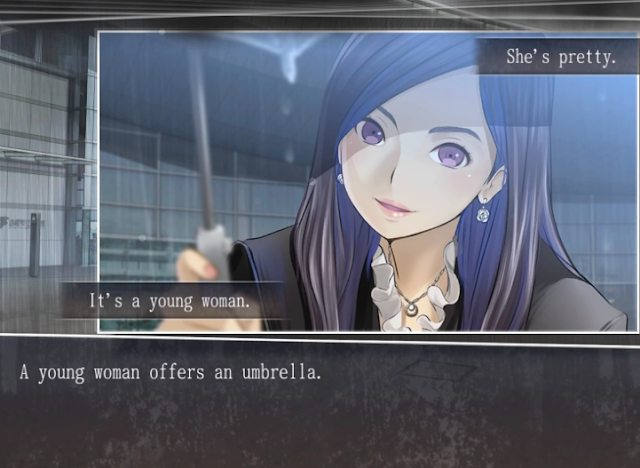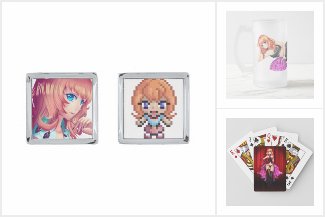Review by Matt S.
Root Letter is one beautiful detective mystery. It’s a visual novel, so for the most part you’re looking at static images of backgrounds and portraits of the various characters, but every single part of every single image drips with the most subtle, elegant, deft touch of true talent. Minoboshi Tarou’s involvement with the project (the artist formerly with Konami working on the equally beautiful Love Plus games) always ensured that this game would carry a subtle, soft edge to it, and the effect perfectly matches the nostalgic, rural setting for the narrative itself.
Related reading: For the visual novel detective genre, it’s hard to look past Danganronpa as the very finest. Matt’s full review.
I do wonder – and worry – whether the beauty will be lost on a lot of players. By now we’re used to the kind of powerful and bold style that most anime adopts. Artists aim to grab and maintain an audience’s attention through thick, bold drawings and bombastic use of colour, and it generally works to the strengths of the genre – simple storytelling and enthusiastic energy. But Tarou’s work instead wants you to lose yourself in it. It’s a deeply immersive art style that all but demands that you carefully pore over each image and study each character in order to appreciate just how distinctive and beautiful they are. Part of the reason that the game works as a detective story is that it frequently asks you to apply a magnifying glass to a scene in order to detect clues, and that means carefully looking over an image to take in every detail. Then you’ll care about the small town that your protagonist is exploring and the people he’s meeting along the way.
But I’m getting ahead of myself. Root Letter, beyond being utterly beautiful, is a rich detective story masquerading as a game. When I interviewed the producer of the game back at Tokyo Game Show, he kept insisting that this was an adventure game rather than a visual novel, but I wish he had just embraced what the game really is; there’s very little room to do anything but what the narrative wants you to. You might be in a conversation with a character, but if you’re given three dialogue options, only one of them will actually progress the story. If you’re in a conversation with that character and decide you want to go somewhere else, the game will stop you from doing that and provide you with a helpful message telling you what you need to do next.
What a beautiful intro. I am so looking forward to this. #PS4share pic.twitter.com/LVlePMUxAg— Miku McMikuFace (@DigitallyDownld) November 1, 2016
Thankfully the story is really worth taking in. It starts out innocuous enough. A man had a penpal 15 years earlier, Aya, and discovers a letter from her that he never realised he had; in it she claims she’s going to kill someone, and he’ll never hear from her again. Nostalgia gets the better of him and he decides to investigate what happened to her… and indeed if she’s still alive. Upon arrival in her home town (Matsue in Shimane prefecture, which is a real place in Japan, represented faithfully here), weird things start happening, not least of which is the girl’s high school friends all insisting that they have no idea who she is, and that the only girl to go by “Aya” actually died 25 years ago. Cue all kinds of speculation about ghosts and even more weird things as our hero goes diligently about trying to figure out what really went on.
Putting aside the mystery (which is well-written and manages to be both surprising and mysterious throughout), Root Letter’s core theme is that special nostalgia that comes from reading old letters. It’s quite poignant, too. While I was in Japan I actually watched a television show about a man (Australian, no less) who was trying to track down his own penpal in Japan from decades previous. As a kid myself I had a penpal, and I often wonder what happened to her (though for now I lack the inclination to actually go on a trip to try and figure it out).
Leafing through old letters and remembering what it was like to correspond with someone far away is an experience that social media can’t really replace. Those letters aren’t fleeting flashes of digital data, consumed in one second and gone a second later. They are physical artefacts of a unique kind of relationship that developed slowly, but would actually become quite deep, because you were exchanging thoughts in long form with another person. As far as I’m concerned the most important moments of Root Letter are those when the protagonist is re-reading the letters Aya wrote to him. There’s a romantic sentimentality there in the letters that – beyond their utility in helping him to piece together the mystery – demonstrates the impact they had on him as a youth (and, again, suits Tarou’s romantic approach to art). The protagonist laughs at the responses he would give to Aya, seeing them as the nonsense of his developing psyche, and then reminisces over how those letters helped him cope with the stress of school exams.
Supported by a nostalgic and beautiful soundtrack, it’s easy to see that the protagonist isn’t just piecing together a mystery in Root Letter. He’s reconstructing his own youth, and reflecting on how he came to be who he is now. Though the writing occasionally veers towards some silly places when the protagonist is talking to the other characters, for the most part it is remarkably subtle and genuine in reflecting this introverted and internalised narrative.
It’s also no surprise that the developers chose Matsue as the setting for Root Letter. As I’ve discussed in articles in the past, Japan has a deep nostalgia for what it is to be Japanese, and the people generally associate regional and rural cities with that nostalgia. In a very real sense, there is a mirroring effect between the protagonist reminiscing about his youth through those letters, and the Japanese creative team, in their choice of city, reminiscing about Japan itself.
Related reading: Matt’s interview with the producer of Root Letter from Tokyo Game Show 2016.
It’s rare that we have a game that genuinely deserves to be called “elegant”, but Root Letter is that game. It takes a romantic, nostalgic idea, wraps it up in a mystery that is fun to piece together, and does all of that within the context of one of the most beautiful examples of anime art you’ll ever see. I have absolutely no idea how well the game will perform in the market. I suspect poorly, given how utterly Japanese it is and the fact that the core storytelling references an experience for which you really need to be around 30 years of age to have experienced it yourself (penpals sadly died as the Internet was born). But I earnestly hope this game is a success. It’s beautiful both inside and out.
– Matt S.
Editor-in-Chief
Find me on Twitter: @digitallydownld











